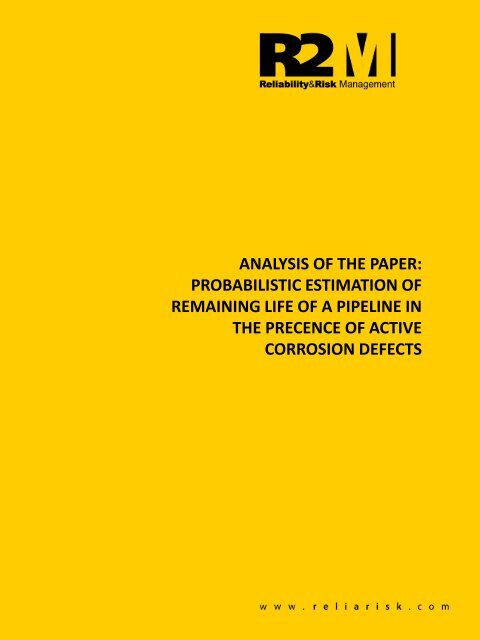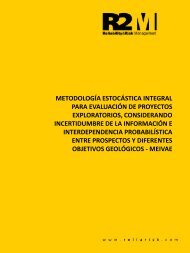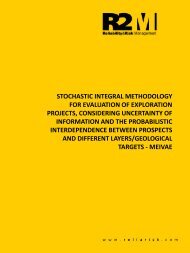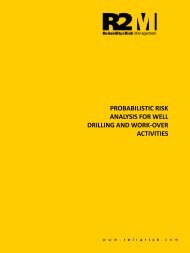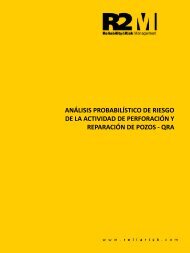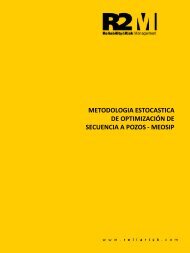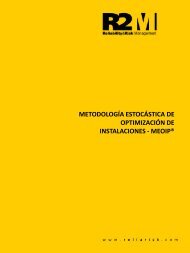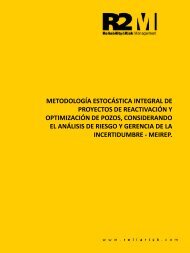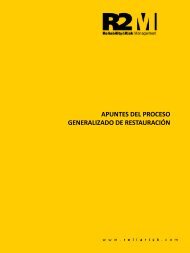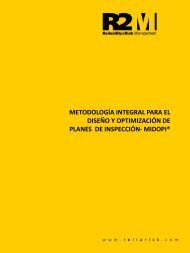Remaining Life of a Pipeline
You also want an ePaper? Increase the reach of your titles
YUMPU automatically turns print PDFs into web optimized ePapers that Google loves.
ANALYSIS OF THE PAPER:<br />
PROBABILISTIC ESTIMATION OF<br />
REMAINING LIFE OF A PIPELINE IN<br />
THE PRECENCE OF ACTIVE<br />
CORROSION DEFECTS
ANALYSIS OF THE PAPER:<br />
PROBABILISTIC ESTIMATION OF REMAINING LIFE OF A PIPELINE<br />
IN THE PRECENCE OF ACTIVE CORROSION DEFECTS<br />
By: MEDARDO YANEZ<br />
email: www.reliarisk.com<br />
MARYLAND 12/14/2001
Table <strong>of</strong> Content<br />
1.- Summary ..................................................................................................................................... 3<br />
2.- Backgroun <strong>of</strong> the work. ................................................................................................................ 3<br />
2.2.- Motivation ......................................................................................................................... 3<br />
2.3.- Previous work.................................................................................................................... 3<br />
3.-The proposed physical model............................... ........................................................................ 4<br />
3.1.- Failure pressure model ..................................... ................................................................4<br />
3.2.- Corrosion Model........................................... ..................................................................... 8<br />
4.- Statistical and Reliability analysis..................... ............................................................................ 9<br />
4.1.- Introduction .................................................. .................................................................. ..9<br />
4.2.- Methodology.......................................... .......................................................................... 10<br />
4.2.1.- Uncertainty propagation (Example)................................. ......................................11<br />
4.2.2.- Stress-Strength Interference (Example)............. ...................................................14<br />
4.2.3.- Sensitivity Analysis.......................................... ..................................................... 15<br />
4.2.4.- System Analysis................................... ................................................................ 17<br />
5.- Limitations <strong>of</strong> the proposed approach........................... ............................................................ 17<br />
6.- Proposed Improvements................................................... ............................................ ............ 18<br />
6.1.- About the Physical Model ...................... ......................................................................... 18<br />
6.2.- About the Statistical Analysis................ .......................................................................... 19<br />
7.- Conclusions............................................................ ................................................................... 27<br />
8.- References ...................................................... .......................................................................... 29<br />
Apendix 1 : Approach for the statistical estimation <strong>of</strong> wall thickness loss.... ............................ 31<br />
Apendix 2 : ASME B31G-1991..................................................... ..............................................37<br />
2
1. Summary<br />
The present work is basically focused on the analysis <strong>of</strong> a technical paper developed by M.<br />
Ahammed, from the University <strong>of</strong> Newcastle – Australia, which shows a probabilistic approach for the<br />
assessment <strong>of</strong> remaining life <strong>of</strong> a pressurized pipeline containing active corrosion defects.<br />
The methodology proposed by M. Ahammed arises from a failure pressure model, based on fracture<br />
mechanics, in which the remaining strength <strong>of</strong> a corroded pipeline depends on several variables. In<br />
this case, contrary to the traditional method <strong>of</strong> estimation <strong>of</strong> remaining life in corroded pipelines<br />
(ASME B31G), these variables are recognized as random variables and so is the remaining strength.<br />
Because <strong>of</strong> this important consideration, the methodology considers the use <strong>of</strong> statistical techniques<br />
to evaluate uncertainty propagation in the estimation <strong>of</strong> the present remaining strength and reliability<br />
analysis to predict its future behavior. Such a prediction becomes a very useful tool from the pipeline<br />
operator’s perspective because it allows him to estimate safe operating pressures at any time and to<br />
prepare effective and economic inspection, repair and replacement operation schedules.<br />
The Ahammed’s work will be analyzed from two different perspectives:<br />
Analysis <strong>of</strong> the physical model (section three (3))<br />
<br />
Analysis <strong>of</strong> the statistical techniques used to evaluate the uncertainty propagation and reliability<br />
analysis. (sections four (4) and five (5))<br />
Additionally, in section six, some improvements concerning the physical model and also two different<br />
methods for the statistical analysis are proposed. These improvements are shown using the data<br />
provided by Ahammed and also using data coming from the oil industry, specifically, from a highpressure<br />
transmission gas pipeline.<br />
2. Background <strong>of</strong> the work<br />
2.1. Motivation: It is a well-known fact that steel pipelines are very important structures in the<br />
process industry and that a very important part <strong>of</strong> the total pr<strong>of</strong>it <strong>of</strong> these industries depends on the<br />
reliability <strong>of</strong> these pipelines. It is also known that as all other structures, pipelines deteriorate over the<br />
time and in this deterioration process usually the dominant mechanism is corrosion. Therefore, the<br />
operation and maintenance <strong>of</strong> pressured pipelines is a major concern and it becomes a risky task in<br />
aged pipelines because <strong>of</strong> the corrosion and its potential damaging effects.<br />
All the facts previously mentioned support the need <strong>of</strong> a methodology to evaluate the pipeline current<br />
reliability and also its time dependent change.<br />
2.2. Previous works: Among the available techniques to obtain an estimate <strong>of</strong> the remaining<br />
strength <strong>of</strong> a pipeline containing corrosion defects, the most widely accepted and used is the<br />
ANSI/ASME B31G ( Manual for Determining the <strong>Remaining</strong> Strength <strong>of</strong> Corroded <strong>Pipeline</strong>s, 1984), (<br />
3
see apendix # 2), which is resumed in the flow diagram shown in fig. 1<br />
The B31G as most <strong>of</strong> the available methods is a<br />
deterministic approach which uses nominal values<br />
for the parameters considered in strength and<br />
stress calculation.<br />
fig.1<br />
3. The proposed Physical Model<br />
3.1. Failure Pressure Model<br />
The failure pressure model presented by M. Ahammed is based on the fundamental mechanical<br />
theory <strong>of</strong> “thin-walled cyilinders”. Cylinders having internal-diameter-to-thickness ratios (D/T) grater<br />
than 10 are usually considered thin-walled cylinders. <strong>Pipeline</strong>s are usually treated as such.<br />
The most important consideration about thin-walled cylinders is that the assumption <strong>of</strong> constant<br />
stress across the wall results in a negligible error.<br />
The fig.3 shows the acting forces and stresses over a<br />
half <strong>of</strong> a thin-walled cylinder, and its dimensions:<br />
Sp = circumferential or hoop stress<br />
p = internal pressure<br />
D = pipeline internal diameter<br />
e = unit length<br />
fig.3<br />
T = wall thickness<br />
4
The equilibrium equation reveals that:<br />
Sp<br />
pD .<br />
2 T<br />
(i)<br />
Sp.(T.e) + Sp.(T.e) = p.(D.e) ; then<br />
Making Sp stress = Sp strength , we get:<br />
.<br />
where, pf = failure pressure<br />
pf<br />
2Sp . .<br />
strength<br />
T<br />
D<br />
(ii)<br />
Equation (i) and (ii) are based on the following considerations:<br />
<br />
<br />
<br />
<br />
<br />
<br />
External pressure is negligible compared to internal pressure<br />
The material obeys Hooke’s law.<br />
The radial stress in negligible<br />
The normal or circumferential stress is linear<br />
Fluid density is relatively small compared o fluid pressure<br />
The shell is assumed perfectly round and <strong>of</strong> uniform thickness.<br />
Among all the assumptions previously considered, the most critical is the last one, which assumes the<br />
shell <strong>of</strong> the pipeline as “perfectly round and <strong>of</strong> uniform thickness”. This assumption is not longer valid<br />
since it is evident that volume defects are generated by corrosion process, affecting both; the<br />
roundness and the wall thickness <strong>of</strong> the pipeline.<br />
Fig.4 shows one <strong>of</strong> such defects, where<br />
<br />
<br />
<br />
T=wall thickness<br />
L=defect length<br />
d=defect depth<br />
Due to the precence <strong>of</strong> a defect, normal hoop force<br />
trajectories along the length and the depth <strong>of</strong> the<br />
defect are interrupted. These interrupted hoop<br />
These<br />
force trajectories are then redistributed around the<br />
defect. This produces a region <strong>of</strong> high stress<br />
fig.4<br />
concentration, which eventually may lead failure <strong>of</strong><br />
the pipeline if the magnitude <strong>of</strong> the concentrated<br />
stress at any region around the defect becomes higher than the pipeline strength (Sp strength ).<br />
5
From the above consideration, it is clear that the pipeline strength “Sp strength “ is affected by the<br />
presence <strong>of</strong> corrosion defects. Regarding this particular issue, several researchers have proposed<br />
different equations to predict the Sp strength <strong>of</strong> a pipeline containing a finite longitudinal corrosion defect.<br />
Among these models the most widely used was developed by Mok ( reference1)<br />
Sp strength<br />
Sf.<br />
1<br />
1<br />
A<br />
Ao<br />
A<br />
( Ao . M )<br />
(iii)<br />
where:<br />
<br />
<br />
Sp strength = Predicted hoop stress level at failure<br />
(Mpa)<br />
Sf = flow strength <strong>of</strong> the pipe material<br />
A = Projected area <strong>of</strong> defect on an axial plane through the wall thickness (mm 2 )<br />
Ao = Original cross-sectional area <strong>of</strong> the pipe at the defect (mm 2 )<br />
<br />
M = Folias or bulging factor<br />
About equation (iii) there are other considerations.<br />
• Consideration #1<br />
Areas “A” and “Ao” can be obtained by the following relationships:<br />
Ao = L . T (iv) ( see fig. 4)<br />
A = L . d (v) ( see fig. 4)<br />
Equation (v) is suggested in B31G Method, (see apendix #1) to calculate the metal area loss from<br />
the overall axial length (L) and the average depth (d) <strong>of</strong> the defect.<br />
Fortunately, corrosion defects in pipelines can be detected by the use <strong>of</strong> a high-resolution magnetic<br />
“pic, which can be used to locate and to measure the size <strong>of</strong> a corrosion defect. Through periodic<br />
inspections, the growth <strong>of</strong> a corrosion defect can also be monitored using ultrasonic techniques.<br />
Substituing equations (iv) and (v) into equation (iii), it becomes:<br />
Sp strength<br />
Sf.<br />
1<br />
1<br />
d<br />
T<br />
d<br />
( TM . )<br />
(vi)<br />
• Consideration #2<br />
The flow strength (Sf) is a material property and is related to material yield strength (Sf). There are<br />
several relatipnships avalable in the literature but the most recent researches about this topic (<br />
references 2,3,4 and 5) propose the following experimentally obtained expression:<br />
Sf = Sy + 68.95 Mpa (vii) ; where Sy = Yield Strength <strong>of</strong> the pipeline material<br />
6
This relationship is particularly appropriated for the carbon steels commonly used in pipelines<br />
By substitution <strong>of</strong> equation (vii) into equation (vi), we get the following expression:<br />
d<br />
1<br />
T<br />
Sp strength<br />
( Sy 68.95)<br />
. (viii)<br />
d<br />
1<br />
( TM . )<br />
• Consideration #3<br />
The folias factor (M) is the value, which account for the stress concentration around the defect. There<br />
have been developed several expressions for the folias factor, but the last, more exact and less<br />
conservative approximation <strong>of</strong> “M” was proposed by Kiefner and Vieth (references 7 and 8), and it is<br />
expressed as follow:<br />
where:<br />
M 1 0.6275. L2<br />
DT . 0.003375.<br />
L 4<br />
D 2 . T 2<br />
(ix)<br />
<br />
<br />
T=wall thickness<br />
L=defect length<br />
<br />
D=pipe diameter<br />
By substitution <strong>of</strong> equation (ix) into equation (viii), we get the following expression:<br />
Sp strength<br />
( Sy 68.95)<br />
.<br />
1<br />
d<br />
1<br />
T<br />
d<br />
T.<br />
1 0.6275. L2<br />
DT . 0.003375.<br />
L 4<br />
D 2 . T 2<br />
(x)<br />
Equation (x) express the pipeline strength (Sp strength ) taking into account the stress concentration<br />
around the corrosion defects, therefore it can be substituited into equation (ii) to form the failure<br />
pressure model presented by M. Ahammed, which can be express as follow:<br />
pf 2. T<br />
( Sy 68.95)<br />
.<br />
D<br />
.<br />
1<br />
d<br />
1<br />
T<br />
d<br />
T.<br />
1 0.6275. L2<br />
DT . 0.003375.<br />
L 4<br />
D 2 . T 2<br />
(xi)<br />
7
3.2. Corrosion Model<br />
Corrosion is the destructive attack <strong>of</strong> a metal by chemical or electrochemical reaction with its<br />
environment. The major classifications <strong>of</strong> corrosion given by Fontana ( Reference # 9) are:<br />
<br />
Erosion corrosion<br />
<br />
Crevice corrosion<br />
<br />
Galvanic corrosion<br />
<br />
Stress corrosion cracking<br />
<br />
Uniform attack<br />
<br />
Selective leaching<br />
<br />
Pitting corrosion<br />
<br />
Intergranular corrosion<br />
<br />
Cavitation<br />
Corrosion is such a complex failure mechanism, which can damage a metal surface in many different<br />
ways. The work developed by M. Ahammed is particularly concern with those types <strong>of</strong> corrosion<br />
which produce macroscopic defects due to material losses, because these defects results in the<br />
reduction <strong>of</strong> the metal cross section with its correspondent reduction <strong>of</strong> the pipeline strength (Sp strength .<br />
Such corrosion types are erosion, pitting corrosion and uniform attack.<br />
This approach is not because <strong>of</strong> simplicity, but because <strong>of</strong> the experience in analyzing pipeline<br />
failures, which has shown that for most <strong>of</strong> the common industrial applications, pipeline failures aren’t<br />
due to other types <strong>of</strong> corrosion than the ones mentioned. Nevertheless, for complex applications, as<br />
nuclear applications or operating conditions with extremely high stress solicitude, a more extensive<br />
analysis is required.<br />
The Ahammed’s considerations about corrosion are focused in the growth rate <strong>of</strong> macro-defects.<br />
The growth <strong>of</strong> macro defects is directly related with the exposure period and depends on the<br />
characteristics <strong>of</strong> the pipeline material, properties <strong>of</strong> the fluid being transported and the surrounding<br />
environment. It has been found that this rate is high during an initial period and then gradually<br />
decrease to finally reach a steady-state rate.<br />
The researches cited by Ahammed (Southwell et al. Reference # 10) shown that the initial period <strong>of</strong><br />
relatively high corrosion rate, (about a year in average), is not <strong>of</strong> much concern because during this<br />
period the defects are usually small and hence do not pose much threat to pipeline integrity.<br />
As the exposure period increases, the growth rate decreases, but the overall size <strong>of</strong> corrosion defect<br />
increases and becomes a greater risk for the pipeline integrity. By this time, the steady-state growth<br />
rate is a good approximation.<br />
8
The following expressions are suggested for the growth rate during the steady state period:<br />
Rd<br />
d<br />
t<br />
do<br />
to<br />
then, d do Rd.<br />
( t to)<br />
(xii)<br />
Where:<br />
<br />
<br />
Rl<br />
Rd=steady state corrosion rate in the direction <strong>of</strong> depth<br />
do=measured depth <strong>of</strong> the defect at the time t=to<br />
L Lo<br />
t to then, L Lo Rl.<br />
( t to)<br />
(xiii)<br />
Where:<br />
<br />
<br />
Rl=steady state corrosion rate in the direction <strong>of</strong> length<br />
Lo=measured length <strong>of</strong> the defect at the time t=to<br />
Other approach for the estimation <strong>of</strong> the corrosion growth rate will be proposed in Appendix #2<br />
.<br />
3.3. Failure pressure model + corrosion defect growth model:<br />
Finally, by substituing equations (xii) and (xiii) in equation (xi), we get the failure pressure model<br />
which take into account the effect <strong>of</strong> continued corrosion.<br />
pf 2. T<br />
( Sy 68.95)<br />
.<br />
D<br />
.<br />
1<br />
1<br />
( do Rd.<br />
t )<br />
T<br />
( do Rd.<br />
t )<br />
Lo Rl.<br />
T.<br />
( t ) 2<br />
1 0.6275. DT . 0.003375.<br />
( Lo Rl.<br />
t ) 4<br />
D 2 . T 2<br />
(xiv)<br />
4. Statistical and Reliability Analysis<br />
4.1. Introduction<br />
In a traditional approach, the variables <strong>of</strong> equation (xiv) are treated as deterministic values; therefore,<br />
the obtained failure pressure is also a deterministic value. However, in reality these parameters show<br />
certain degree <strong>of</strong> variability in their values.<br />
The M. Ahammed’s approach recognizes such values as random variables, (each one with a<br />
probability density function, a mean and a variance), therefore the resulting failure pressure is a<br />
9
andom variable with its own degree <strong>of</strong> variability. This variability is the most important factor when<br />
estimating the remaining life <strong>of</strong> a pipeline, and the estimation method <strong>of</strong> such variability is the most<br />
valuable contribution <strong>of</strong> the proposed approach.<br />
4.2. Methodology<br />
4.2.1 Step #1: Uncertainty Propagation<br />
Fig. 5 shows that if the physical model’s inputs are random variables, then, its output must be a<br />
random variable too. The methods to determine the random characteristics <strong>of</strong> the outpus given the<br />
random characteristics <strong>of</strong> the imputs are known as “uncertainty propagation methods” (u.p.m).<br />
Rd<br />
Rl<br />
Physical Model<br />
Lo<br />
do<br />
D<br />
pf( t ) 2. ( Sy 68.95)<br />
. T .<br />
D<br />
1<br />
1<br />
( do Rd.<br />
t )<br />
T<br />
( do Rd.<br />
t )<br />
Lo Rl.<br />
T.<br />
( t ) 2<br />
1 0.6275. DT . 0.003375.<br />
( Lo Rl.<br />
t ) 4<br />
D 2 . T 2<br />
Pf<br />
Sy<br />
Sy<br />
fig.5<br />
The u.p.m selected by M. Ahammed is know as “advanced first order second moment method”. This<br />
method is based on the Taylor series:<br />
(xv)<br />
Where X 1 , X 2 , X 3 ,...., X n<br />
respective mean values.<br />
are the “n” random variables or imputs and µ 1 , µ 2 , µ 3 ,...., µ n are their<br />
If the higher terms are neglected and the variables are assumed to be statistically independent, the<br />
mean and the variance <strong>of</strong> the function are given by:<br />
(xvi)<br />
(xvii)<br />
10
A continuation, this method is run for the data provided by M Ahammed and the physical model <strong>of</strong><br />
equation (xiv). It is done using MathCad 5.<br />
Tabla 1 shows the values and characteristics <strong>of</strong> the inputs random variables provided by M<br />
Ahammed.<br />
Variable Mean Value Standar Deviation pdf<br />
Sy 423 0.002239477 Log - Normal<br />
Rd 0.1 0.02 Normal<br />
Rl 0.1 0.02 Normal<br />
do 3 0.3 Normal<br />
Lo 200 10 Normal<br />
D 600 18 Normal<br />
T 10 0.5 Normal<br />
table 1<br />
4.2.1.1. Example 1: Estimation <strong>of</strong> µ Pf and σ Pf for t = 30 years<br />
Approximate Method (Taylor Serie)<br />
t 30<br />
Do 3 S 4<br />
0.3 Rd 0.1 S 2<br />
0.02 T 10 S 1<br />
0.5<br />
D 600 S 5<br />
18<br />
Lo 200 S 7<br />
10<br />
Pa 5<br />
Rl 0.1 S 3<br />
0.02<br />
Sy 423 S 6<br />
0.002239477497<br />
T<br />
Pf 2 . ( Sy 68.95 ) .<br />
D<br />
.<br />
1<br />
1<br />
( Do Rd . t)<br />
T<br />
( Do Rd . t)<br />
(( Lo Rl . t)<br />
) 2<br />
T . 1 0.6275 .<br />
DT . 0.003375 .<br />
(( Lo Rl . t)<br />
) 4<br />
D 2 . T 2<br />
Pf = 8.917<br />
d<br />
C 1 dT T<br />
2 . ( Sy 68.95 ) .<br />
D<br />
.<br />
1<br />
1<br />
( Do Rd . t)<br />
T<br />
( Do Rd . t)<br />
(( Lo Rl . t)<br />
) 2<br />
T . 1 0.6275 .<br />
DT . 0.003375 .<br />
(( Lo Rl . t)<br />
) 4<br />
D 2 . T 2<br />
C = 2.033 1<br />
11
C 2<br />
d<br />
dRd<br />
2 .<br />
T<br />
( Sy 68.95 ) .<br />
D<br />
.<br />
1<br />
1<br />
( Do Rd . t)<br />
T<br />
( Do Rd . t)<br />
(( Lo Rl . t)<br />
) 2<br />
T . 1 0.6275 .<br />
DT . 0.003375 .<br />
(( Lo Rl . t)<br />
) 4<br />
D 2 . T 2<br />
C = 50.852<br />
2<br />
C 3<br />
d<br />
dRl<br />
2 .<br />
T<br />
( Sy 68.95 ) .<br />
D<br />
.<br />
1<br />
1<br />
( Do Rd . t)<br />
T<br />
( Do Rd . t)<br />
(( Lo Rl . t)<br />
) 2<br />
T . 1 0.6275 .<br />
DT . 0.003375 .<br />
(( Lo Rl . t)<br />
) 4<br />
D 2 . T 2<br />
C = 0.367 3<br />
C 4<br />
d<br />
dDo<br />
2 .<br />
T<br />
( Sy 68.95 ) .<br />
D<br />
.<br />
1<br />
1<br />
( Do Rd . t)<br />
T<br />
( Do Rd . t)<br />
(( Lo Rl . t)<br />
) 2<br />
T . 1 0.6275 .<br />
DT . 0.003375 .<br />
(( Lo Rl . t)<br />
) 4<br />
D 2 . T 2<br />
C = 1.695 4<br />
C 5<br />
( Do Rd . t)<br />
1<br />
d<br />
T<br />
T<br />
2 . ( Sy 68.95 ) . .<br />
dD<br />
D<br />
( Do Rd . t)<br />
C = 0.013<br />
1<br />
5<br />
(( Lo Rl . t)<br />
) 2<br />
T 1 0.6275 .<br />
(( Lo Rl . t)<br />
) 4<br />
.<br />
DT . 0.003375 .<br />
D 2 . T 2<br />
C 6<br />
( Do Rd . t)<br />
1<br />
d<br />
T<br />
T<br />
2 . ( Sy 68.95 ) . .<br />
dSy<br />
D<br />
( Do Rd . t)<br />
C = 0.018<br />
1<br />
6<br />
(( Lo Rl . t)<br />
) 2<br />
T 1 0.6275 .<br />
(( Lo Rl . t)<br />
) 4<br />
.<br />
DT . 0.003375 .<br />
D 2 . T 2<br />
C 7<br />
( Do Rd . t)<br />
1<br />
d<br />
T<br />
T<br />
2 . ( Sy 68.95 ) . .<br />
dLo<br />
D<br />
( Do Rd . t)<br />
C = 0.012<br />
1<br />
7<br />
(( Lo Rl . t)<br />
) 2<br />
T 1 0.6275 .<br />
(( Lo Rl . t)<br />
) 4<br />
.<br />
DT . 0.003375 .<br />
D 2 . T 2<br />
Var<br />
7<br />
2<br />
C .<br />
2 Si i<br />
µpf Pf µpf = 8.917<br />
i = 1<br />
σpf Var σpf = 1.547<br />
12
This method can be applied for any value <strong>of</strong> the time “t” in order to estimate the mean and the<br />
variance <strong>of</strong> the failure pressure or remaining strength. Table 2 shows the results gotten for t =<br />
20,30,40 and 50 years<br />
Time “t” (years) µ Pf (Mpa) σ Pf (Mpa) cov=σ Pf/ µ Pf<br />
20 10.527 1.259 0.1196<br />
30 8.917 1.547 0.1734<br />
40 7.102 1.978 0.2785<br />
50 5.044 2.57 0.5095<br />
table 2<br />
From table 2 it can be noticed that there is a clear “drift” in the mean <strong>of</strong> the remaining strength and<br />
also the dispersion <strong>of</strong> the its distribution increases with time (diffusion). Both trends are shown in fig.6<br />
Pf(t)<br />
Pdf(Pf)<br />
at t 1<br />
pf( t ) 2. ( Sy 68.95)<br />
. T .<br />
D<br />
1<br />
1<br />
( do Rd.<br />
t )<br />
T<br />
( do Rd.<br />
t )<br />
Lo Rl.<br />
T.<br />
( t ) 2<br />
1 0.6275. DT . 0.003375.<br />
( Lo Rl.<br />
t ) 4<br />
D 2 . T 2<br />
Pdf(Pf)<br />
at t 2<br />
Pdf(Pf)<br />
at t n-1<br />
In Fig. 6 it is assumed<br />
a Normal or Gaussian<br />
as the distribution <strong>of</strong><br />
“Pf”.<br />
t 1 t 2<br />
fig.6<br />
At this point it is important to say that the method proposed by M. Ahammed is able to give us<br />
information about the values <strong>of</strong> the mean and the standard deviation <strong>of</strong> the failure pressure at any<br />
time, but doesn’t give information about the probability distribution model that better fits the<br />
distribution <strong>of</strong> “Pf”. Therefore the confident level <strong>of</strong> this estimation can not be calculated precisely. In<br />
addition the coefficient <strong>of</strong> variation (cov), shown in table 2, can be interpreted as a measure <strong>of</strong> the<br />
t -n-1<br />
t(years)<br />
13
confidence <strong>of</strong> our estimation.<br />
In section six (6) a Montecarlo approach is proposed to avoid the limitations mentioned.<br />
4.2.2. Step #2: Stress-Strength Interference Reliability Analysis<br />
P (Mpa(<br />
Mpa)<br />
Pdf(Pf)<br />
at t 1<br />
∞⎡<br />
∞<br />
⎤<br />
R ( t)<br />
= ∫∫ ⎢ pdf ( Pa)<br />
d<br />
Pa ⎥pdf<br />
( Pf ) d<br />
0 ⎢⎣<br />
Pf<br />
⎥⎦<br />
Pf<br />
Fig. 7 shows that the mean value <strong>of</strong> the remaining<br />
strength “Pf” decreases with the time increment ,<br />
and also increases its dipersion. At time t = t 1 , the<br />
Pdf(Pf)<br />
STRENGTH<br />
Pdf(Pf)<br />
at t n-1<br />
distribution <strong>of</strong> “Pf” (pdf(Pf)) is still far from the<br />
stress distribution(pdf(Pa)), (Pa = service<br />
pressure), but at time t = t n –1 there are certain<br />
degree <strong>of</strong> overlap between both distributions. This<br />
Pdf(Pa)<br />
STRESS<br />
t 1<br />
fig.7<br />
t -n-1<br />
t(years)<br />
degree <strong>of</strong> overlap is proportional to the probability<br />
<strong>of</strong> failure<br />
The estimation <strong>of</strong> the reliability <strong>of</strong> the pipeline in presence <strong>of</strong> active corrosion defects can be obtained<br />
by the expression show in fig. 7<br />
∞<br />
⎡<br />
∞<br />
⎤<br />
R ( t ) ∫ ⎢ ∫ pdf ( Pa ) d<br />
Pa ⎥ pdf ( Pf ) d<br />
0 ⎢⎣<br />
Pf<br />
⎥⎦<br />
= (xviii)<br />
Pf<br />
To solve the integral <strong>of</strong> equation (xviii) it is necessary to know the pdf <strong>of</strong> Pf, which is not possible with<br />
the method, described in step 1; nevertheless, in the Ahammed approach an approximation is<br />
proposed by defining the random variable “Z”<br />
Z = Pf – Pa<br />
(xix)<br />
Assuming Z to be normally distributed, the pipeline failure probability corresponding to the defect “i” is<br />
defined as<br />
P i = Prob. (Z
β<br />
( Pf Pa )<br />
β = 4.081<br />
Var 0.5 2<br />
F 1 pnorm ( β , 0 , 1 ) Rel 1 F<br />
F = 2.238 10 5<br />
Rel = 1<br />
Table 3 shows the results gotten for t = 20,30,40 and 50 years<br />
Time “t” (years) β F i R i<br />
20 4.081 2.238.10 -5 1<br />
30 2.409 0.008 0.992<br />
40 1.030 0.141 0.849<br />
50 0.017 0.493 0.507<br />
4.2.3. Step # 3: Sensitivity Analysis:<br />
table 3<br />
The sensitivity analysis allows us to know the relative contributions <strong>of</strong> the various individual random<br />
variables to the variance <strong>of</strong> the failure function. Each contribution can be calculated using the<br />
following expression:<br />
α<br />
2<br />
X<br />
i<br />
=<br />
⎛ ∂f<br />
( x1,<br />
x2,<br />
x3,....<br />
x<br />
⎜<br />
⎝ ∂xi<br />
2<br />
σ<br />
f<br />
n<br />
) ⎞<br />
⎟<br />
⎠<br />
2<br />
(xxii)<br />
In the following page, the sensitivity analysis for the failure pressure model is shown, for a time period<br />
t=20 years.<br />
The analysis showed that in this case only the dispersion <strong>of</strong> the values <strong>of</strong> the wall thickness “T”, the<br />
radial corrosion growth rate “Rd” and the defect depth “do”, have a considerable effect in the<br />
dispersion <strong>of</strong> the values <strong>of</strong> the remaining strength “Pf” and in consequence, in the reliability estimation<br />
<strong>of</strong> the pipeline.<br />
15
Sensitivity Analysis<br />
Contribution <strong>of</strong> the wall thicknes "T"<br />
Contribution <strong>of</strong> the radial corrosion growth rate"Rd"<br />
2<br />
C .<br />
2 S1 1<br />
α 1<br />
σpf 2 α 1<br />
0.764<br />
2<br />
C .<br />
2 S2 2<br />
= α 2<br />
σpf 2 α = 0.479 2<br />
Contribution <strong>of</strong> the longitudinal corrosion<br />
growth rate"Rl"<br />
Contribution <strong>of</strong> the corrosion depth at t = to "Do"<br />
2<br />
C .<br />
2 S3 3<br />
α 3<br />
σpf 2 α 3<br />
3.639 10 3<br />
2<br />
C .<br />
2 S4 4<br />
= α 4<br />
σpf 2 α = 0.359 4<br />
Contribution <strong>of</strong> the pipe diameter "D"<br />
2<br />
C .<br />
2 S5 5<br />
α 5<br />
σpf 2 α = 0.223 5<br />
Contribution <strong>of</strong> the yield strength <strong>of</strong> the<br />
pipeline material "Sy"<br />
2<br />
C .<br />
2 S6 6<br />
α 6<br />
σpf 2 α = 3.808 10 5<br />
6<br />
Contribution <strong>of</strong> the corrosion length at t = to "Lo"<br />
i 1, 2..<br />
7<br />
2<br />
C .<br />
2 S7 7<br />
α 7<br />
σpf 2 α = 0.091 7<br />
7<br />
i = 1<br />
α i<br />
2<br />
= 1<br />
% 100 . 2<br />
α i i<br />
60<br />
% contribution on the var. <strong>of</strong> Pf<br />
wall thickness<br />
<br />
% contribution var. <strong>of</strong> ith R.V<br />
40<br />
Step #4 System Analysis<br />
20<br />
radial corrosion<br />
growth rate<br />
defect depth<br />
0<br />
0 1 2 3 4 5 6 7 8<br />
16
% contribution<br />
80<br />
60<br />
40<br />
20<br />
0<br />
1 2 S1<br />
3 4 5 6 7<br />
variables<br />
20 years 30 years 40 years<br />
fig.8<br />
Fig. 8 shows the contributions <strong>of</strong> the<br />
variables to the variance <strong>of</strong> the<br />
remaining strength “Pf” for different<br />
periods <strong>of</strong> time.<br />
It is clear that the major contributions<br />
come from the wall thickness “T”, the<br />
radial corrosion growth rate “Rd”, and<br />
the defect depth “do”, (variables 1, 2<br />
and 4 respectively), consistently over<br />
the time<br />
4.2.4. Step # 4: System Analysis<br />
The system analysis perspective is required when considering more than one defect per pipeline,<br />
which is normally the case. In such case, the pipeline can be modeled as a serial system because<br />
each defect is able to cause the pipeline to fail.<br />
Let us designate these defects by 1,2,3.......n and the corresponding failure probabilities by P f1 ,P f2<br />
,P f3. .............. P fn respectively. Then the probability <strong>of</strong> failure for the pipeline can be estimated by:<br />
P f (pipeline) = 1-(1- P f1 ).(1- P f2 ).(1- P f3 )................(1- P fn )<br />
(xxiii)<br />
5. Limitations <strong>of</strong> the proposed approach<br />
At this point it is important to summarize the limitations <strong>of</strong> the approach proposed by M. Ahammed in<br />
order to establish the boundaries for its reasonable use.<br />
5.1. Limitations about the proposed Physical Model<br />
<br />
The physical model proposed accounts only for those types <strong>of</strong> corrosion, which produce<br />
macroscopic defects due to material losses, such as corrosion erosion, pitting corrosion and<br />
uniform attack. For complex applications such as nuclear plants or operating conditions with<br />
extremely high strength solicitude, other corrosion mechanisms such as intergranular corrosion,<br />
stress corrosion cracking or selective leaching must be considered; then, a more extensive<br />
analysis is required.<br />
5.2. Limitations about the proposed method for statistical and reliability analysis<br />
<br />
The “ Advanced first order-second moment method” proposed to estimate the resulting variability<br />
17
<strong>of</strong> the remaining strength (Pf) given the variability <strong>of</strong> the input values, allows for the estimation <strong>of</strong><br />
its mean value and its standard deviation, but is not able to provide its “distribution function” or<br />
pdf (Pf). In consequence, a precise calculation <strong>of</strong> the confidence interval for this estimate is not<br />
possible. In section six (6) “Proposed Improvements”, an approach to avoid this limitation is<br />
proposed.<br />
6. Proposed Improvements<br />
6.1. About the Physical Model<br />
6.1. 1. Incorporation <strong>of</strong> an Erosion Corrosion Physics Based Model:<br />
The availability <strong>of</strong> relationships defining either mass transfer or erosion corrosion fron surfaces is<br />
extremaly limited, even though, recent work has indicated that once a surface is roughened, the rate<br />
<strong>of</strong> mass transfer is governed by roughness, not the geometry <strong>of</strong> the surface. More importantly, the<br />
results indicate that a universal relationship for the mass trensfer for roughened surfaces may exist.<br />
The reaction rate is governed by the Sherwood number (Sh), given as:<br />
K.<br />
d<br />
Sh = (xxiv) , where:<br />
D<br />
K= mass transfer coefficient<br />
d=characteristic speciment length dimension<br />
D=diffusivity <strong>of</strong> the relevant species<br />
Sh = C. Re<br />
x . Sc y = Sherwood number (xxv)<br />
Re= Reynolds number<br />
γ<br />
Sc = = Schmidt number<br />
D<br />
γ = kinematic viscosity<br />
6.1. 2. Approach for the statistical estimation <strong>of</strong> wall thickness loss due to corrosion<br />
The linear model assumed to predict the corrosion growth rate is currently under discussion. In<br />
appendix #1 an extensive analysis <strong>of</strong> data coming from different services in the oil industry, shows<br />
that a more accurate exponential model can be used.<br />
18
6.2. About the Statistical and Reliability Analysis<br />
As it was mentioned in section five (5), the “advanced first order-second moment method” allows us<br />
to estimate its mean value and its standard deviation <strong>of</strong> the remaining strength (Pf), but not its<br />
“distribution function” or pdf (Pf). Therefore the level <strong>of</strong> confidence <strong>of</strong> this estimate can not be<br />
obtained.<br />
To solve this problem, a Montecarlo Approach is proposed. This approach can be really useful if a<br />
precise estimation <strong>of</strong> the confidence interval is required. These calculation where developed using<br />
“MathCad 5”.<br />
Probabilistic estimation <strong>of</strong> remaining life <strong>of</strong> a pipeline<br />
in the precence <strong>of</strong> active corrosion defects<br />
Terms definitions:<br />
Sy = yield strength <strong>of</strong> pipe material<br />
T = Wall Thickness<br />
Do = Measured depth <strong>of</strong> the defect at t=to<br />
Lo = Measured length <strong>of</strong> the defect at t=to<br />
D = Pipe diameter<br />
Rd = Steady-state corrosion rate in the direction <strong>of</strong> depth<br />
Rl = Steady-state corrosion rate in the direction <strong>of</strong> length<br />
M = Folias factor = 1 0.6275. L2<br />
DT . 0.003375.<br />
L 4<br />
D 2 . T 2<br />
L = length <strong>of</strong> the defect at any time (t) = Lo+Rl(t-to)<br />
d = depth <strong>of</strong> the defect at any time (t) = Do=Rd(t-to)<br />
19
1.- Montecarlo Simulation Strength (Pf)<br />
t 30 m 100000 Sy rlnorm( m , ln( 422.0537611)<br />
, 0.002239477497)<br />
Do rnorm( m , 3 , 0.3 ) D rnorm( m , 600 , 18)<br />
Lo rnorm( m , 200 , 10) Rd rnorm( m , 0.1 , 0.02 ) Rl rnorm( m , 0.1 , 0.02 )<br />
T rnorm( m , 10 , 0.5 )<br />
L ( Lo Rl.<br />
t) M 1 0.6275. L2<br />
DT . 0.003375.<br />
F<br />
1<br />
1<br />
( Do Rd.<br />
t )<br />
T<br />
( Do Rd.<br />
t )<br />
TM . Pf 2. T<br />
( Sy 68.95)<br />
.<br />
D<br />
1<br />
.<br />
1<br />
L 4<br />
D 2 . T 2<br />
( Do Rd.<br />
t )<br />
T<br />
( Do Rd.<br />
t )<br />
TM .<br />
P 2. T<br />
( Sy 68.95)<br />
.<br />
D<br />
0<br />
0<br />
1<br />
2<br />
3<br />
7.311<br />
8.149<br />
8.709<br />
7.894<br />
µ<br />
1<br />
m 1<br />
m 1<br />
. Pf i<br />
µ = 8.862<br />
i = 0<br />
4<br />
7.879<br />
Pf =<br />
5<br />
6<br />
7<br />
8<br />
6.432<br />
9.416<br />
9.042<br />
11.187<br />
σ<br />
1<br />
m 2<br />
.<br />
m 1<br />
i = 0<br />
Pf i<br />
µ 2<br />
σ = 1.551<br />
9<br />
7.671<br />
10<br />
9.504<br />
11<br />
7.435<br />
12<br />
8.658<br />
13<br />
11.846<br />
20
1.1.- Determination <strong>of</strong> the pdf <strong>of</strong> "Pf"<br />
Enter desired number <strong>of</strong> bins in the interval: bin 150<br />
Size, mean, and standard deviation <strong>of</strong> the data:<br />
Size n length( Pf ) n = 1 10 5<br />
Mean µ mean( Pf ) µ = 8.862<br />
n<br />
SD σ stdev( Pf ). σ = 1.551<br />
n 1<br />
Frequency distribution:<br />
lower<br />
floor( min( Pf )) upper ceil( max( Pf ))<br />
h<br />
upper<br />
bin<br />
lower<br />
j 0 .. bin<br />
int j<br />
lower h.<br />
j<br />
f<br />
hist ( int , Pf ) int int 0.5 . h<br />
F( y) n . h.<br />
dnorm( y , µ , σ )<br />
3000<br />
2000<br />
1000<br />
As it can be noticed,<br />
the histogrem <strong>of</strong> the<br />
values <strong>of</strong> "Pf", makes<br />
a very good fit with<br />
the norma distribution<br />
0<br />
0 5 10 15 20<br />
Histogram<br />
Normal distribution<br />
21
2.- Simulation Stress (Pa)<br />
Pa rnorm( m , 5 , 0.5 )<br />
Enter desired number <strong>of</strong> bins in the interval: bin 150<br />
Size, mean, and standard deviation <strong>of</strong> the data:<br />
Size n length( Pa ) n = 1 10 5<br />
0<br />
1<br />
2<br />
3<br />
0<br />
4.794<br />
5.133<br />
5.608<br />
5.374<br />
4<br />
5.138<br />
Mean µpa mean( Pa ) µpa = 4.999<br />
n<br />
SD σpa stdev( Pa ). σpa = 0.502<br />
n 1<br />
Frequency distribution:<br />
lower<br />
floor( min( Pa )) upper ceil( max( Pa ))<br />
Pa =<br />
5<br />
6<br />
7<br />
8<br />
9<br />
10<br />
11<br />
5.265<br />
5.028<br />
4.48<br />
4.665<br />
4.81<br />
5.509<br />
5.081<br />
h<br />
upper<br />
bin<br />
lower<br />
j 0 .. bin<br />
12<br />
13<br />
4.936<br />
5.288<br />
int j<br />
lower h.<br />
j<br />
f<br />
hist ( int , Pa ) int int 0.5 . h<br />
G( l) n . h.<br />
dnorm( l , µpa , σpa)<br />
4000<br />
2000<br />
0<br />
3 4 5 6 7<br />
Histogram<br />
Normal distribution<br />
22
3.- Stress-Strength Interference Reliability Estimation<br />
Strength<br />
σ = 1.551 µ = 8.862<br />
f( S)<br />
1 . e<br />
2 . π . σ<br />
1<br />
.<br />
2<br />
S µ<br />
σ<br />
2<br />
100<br />
100<br />
f( S)dS<br />
= 1<br />
Stress<br />
σpa = 0.502 µpa = 4.999<br />
g( s)<br />
1 . e<br />
2 . π . σpa<br />
1<br />
.<br />
2<br />
s<br />
µpa<br />
σpa<br />
2<br />
10<br />
10<br />
g( s)ds<br />
= 1<br />
s 0 , 0.1 .. 20<br />
S 0 , 0.1 .. 20<br />
1<br />
f( S)<br />
g( s)<br />
0.5<br />
0<br />
0 2 4 6 8 10 12 14<br />
S,<br />
s<br />
Rel<br />
100<br />
100<br />
1 . S<br />
2 erf 1 . 2 . 1<br />
S . µpa . 1<br />
2 .<br />
2 σpa 2 σpa 2 erf 1 . 2 . 1<br />
0 . µpa . 2 . f( S)<br />
d<br />
2 σpa 2 σpa<br />
Rel = 0.991<br />
23
4.- Determination <strong>of</strong> the failure state Z=(Pf-Pa)<br />
Z ( Pf Pa)<br />
Enter desired number <strong>of</strong> bins in the interval:<br />
bin 150<br />
Size n length( Z) n = 1 10 5<br />
Z<br />
Mean µz mean( Z) µz = 3.863<br />
n<br />
SD σz stdev( Z)<br />
. σz = 1.629<br />
n 1<br />
Frequency distribution:<br />
lower<br />
floor( min( Z)<br />
) upper ceil( max( Z)<br />
)<br />
=<br />
0<br />
1<br />
2<br />
3<br />
4<br />
5<br />
6<br />
7<br />
8<br />
9<br />
10<br />
11<br />
12<br />
13<br />
0<br />
2.517<br />
3.016<br />
3.1<br />
2.521<br />
2.741<br />
1.168<br />
4.388<br />
4.562<br />
6.522<br />
2.861<br />
3.995<br />
2.354<br />
3.723<br />
6.558<br />
h<br />
upper<br />
bin<br />
lower<br />
j 0 .. bin bin = 150 int j<br />
lower h.<br />
j<br />
f<br />
hist ( int , Z) int int 0.5 . h F( x) n . h.<br />
dnorm( x , µz , σz )<br />
3000<br />
2000<br />
1000<br />
0<br />
4 2 0 2 4 6 8 10 12<br />
Histogram<br />
Normal distribution<br />
Failure Probability=F=Pr(Z>0)<br />
F<br />
0<br />
1000<br />
2<br />
1<br />
.<br />
Z µz<br />
1 . 2<br />
e<br />
σz<br />
d Z<br />
2 π . σz<br />
F 8.859 10 3<br />
=<br />
24
5.- Reliability Prediction<br />
m 100000 t1 1 , 5 .. t 45 Sy rlnorm( m , ln( 422.0537611)<br />
, 0.002239477497)<br />
Do rnorm( m , 3 , 0.3 ) D rnorm( m , 600 , 18) Rl rnorm( m , 0.1 , 0.02 )<br />
Lo rnorm( m , 200 , 10) Rd rnorm( m , 0.1 , 0.02 ) T rnorm( m , 10 , 0.5 )<br />
L t<br />
( Lo Rl.<br />
t1 )<br />
L t1<br />
2<br />
M t1<br />
1 0.6275. DT . 0.003375.<br />
L t1<br />
4<br />
D 2 . T 2<br />
Pf t1<br />
2. T<br />
( Sy 68.95)<br />
.<br />
D<br />
( Do Rd.<br />
t1 )<br />
1<br />
. T<br />
µ<br />
( Do Rd.<br />
t1<br />
mean Pf t1<br />
t1 )<br />
1<br />
.<br />
TM t1<br />
σ t1<br />
stdev Pf . n<br />
t1<br />
n 1<br />
S 0.00001, 0.1 .. 200 z( S)<br />
1 .<br />
2 erf 1 . 2 . 1<br />
S . µpa . 1<br />
2 .<br />
2 σpa 2 σpa 2 erf 1 . 2 . 1<br />
0 . µpa . 2<br />
2 σpa 2 σpa<br />
100<br />
Rel t1<br />
0<br />
z( S)<br />
. 1 . e<br />
d S F t1<br />
1 Rel t1<br />
. 2 . π<br />
σ t1<br />
1<br />
2 . 2<br />
σ t1<br />
.<br />
2<br />
( S ) µ t1<br />
1<br />
Reliability and Failure Prob. vs Time<br />
Rel t1<br />
F t1<br />
0.5<br />
0<br />
0 10 20 30 40 50 60 70<br />
t1 , t1<br />
25
6.- Confidence Intervals Estimation<br />
Y t1<br />
qnorm 0.95 , µ t1<br />
, σ t1<br />
Z t1<br />
qnorm 0.05 , µ t1<br />
, σ t1<br />
Pa t1<br />
µpa<br />
M t1<br />
qnorm( 0.95 , µpa , σpa) N t1<br />
qnorm( 0.05 , µpa , σpa)<br />
15<br />
Pf (Confidence intervals) vs Time<br />
µ t1<br />
10<br />
Y t1<br />
Z t1<br />
5<br />
0<br />
0 10 20 30 40 50 60 70<br />
t1<br />
15<br />
Pf & Pa (Confidence intervals) vs Time<br />
µ t1<br />
Y t1<br />
Z t1<br />
10<br />
Pa t1<br />
M t1<br />
5<br />
N t1<br />
0<br />
0 10 20 30 40 50 60 70<br />
t1<br />
26
7. Conclusions<br />
<br />
The use <strong>of</strong> the physical model proposed by M. Ahammed must be limited for those uses in which<br />
the dominant corrosion mechanisms are corrosion erosion, pitting corrosion and uniform attack.<br />
The experience has shown that these are actually the failure mechanisms for most <strong>of</strong> the<br />
pipelines industrial applications. Nevertheless, for complex applications (nuclear plants or<br />
operating conditions with extremely high strength solicitude), other corrosion mechanisms such<br />
as intergranular corrosion, stress corrosion cracking and selective leaching must be considered;<br />
then, a more extensive analysis is required.<br />
<br />
The proposed statistical treatment <strong>of</strong> the physical model, accounts for the uncertainty due to the<br />
variability <strong>of</strong> the input parameters, but the uncertainty associated with the model by itself is not<br />
included in this study.<br />
There are several sources <strong>of</strong> “model uncertainty” because the final failure pressure model,<br />
proposed by M. Ahammed, was obtained by mixing the equation (ii), which comes from the<br />
classical fracture mechanism theory, with several empirical equations like: eq. (vii), (to establish<br />
the relationship between hoop strength and yield strength), eq. (ix), (to calculate the folias factor)<br />
and equations (xii) and (xiii), (to calculate the corrosion growth rate).<br />
The sensitivity analysis demonstrated that :<br />
• Among the seven parameters included in the physical model, only the variability on the<br />
values <strong>of</strong> the wall thickness “T”, radial corrosion growth rate “Rd” and defect depth “do”, has<br />
important effect on the dispersion <strong>of</strong> the values <strong>of</strong> the remaining strength “Pf”.<br />
• The contribution <strong>of</strong> wall thickness “T” and the defect depth “do” decreases with time, while the<br />
contribution <strong>of</strong> the radial corrosion growth rate “Rd”, increases (see fig. 8). This demonstrates<br />
that “Rd” is the most important parameter to take into account in the analysis <strong>of</strong> the remaining<br />
strength in a pipeline with corrosion defects.<br />
<br />
Being the radial corrosion growth rate “Rd” the most critical parameter, the linear model assumed<br />
to predict the corrosion growth becomes a critical factor, regarding this issue, the following<br />
considerations are important:<br />
• An extensive analysis <strong>of</strong> data, coming from different services in the oil industry, Appendix #1,<br />
shows that a more accurate exponential model (also empirically gotten) can be used to<br />
27
estimate the radial rate <strong>of</strong> corrosion growth (Rd).<br />
• Non empirical models, like equation (xxiv) and (xxv), are not yet in the required level <strong>of</strong><br />
development as to be incorporated in practical applications. Nevertheless, future works in this<br />
area must be focused in the incorporation <strong>of</strong> these physically based models into the final<br />
failure pressure model for pipelines containing active corrosion defects.<br />
• The linear model can be considered a good approximation if the period <strong>of</strong> time under<br />
consideration fall in the corrosion steady state zone.<br />
<br />
The following table resumes the results obtained using the “ Advanced first order-second moment<br />
method” proposed by M. Ahammed and the results obtained with the Montecarlo approach<br />
proposed in section six, for the same set <strong>of</strong> data.<br />
“t” (yrs)<br />
Advanced first order-second moment<br />
method<br />
Montecarlo Simulation Method<br />
Pf 5 %<br />
σ Pf (Mpa) µ Pf (Mpa) F i R i σ Pf (Mpa) µ Pf (Mpa)<br />
percentil<br />
Pf 95 %<br />
percentil<br />
F i<br />
R i<br />
20 1.259 10.527 2.238.10 -5 1 1.257 10.495<br />
8.42<br />
12.5 3.633.10 -4 1<br />
30 1.547 8.917 0.008 0.992 1.551 8.862 6.18 11.2 0.008 0.991<br />
40 1.978 7.102 0.141 0.849 1.995 7.003 3.661 10.2 0.165 0.835<br />
50 2.57 5.044 0.493 0.507 2.619 4.871 0.555 0.3 0.519 0.481<br />
From these results, the following considerations are important:<br />
• There is a clear “drift” in the mean <strong>of</strong> the remaining strength (Pf) and also the dispersion <strong>of</strong> its<br />
distribution increases with time (diffusion). Both trends can be detected using either one<br />
method or the other.<br />
• The “advanced first order-second moment method” allows the estimation <strong>of</strong> the mean value<br />
and the standard deviation, but doesn’t provide us the “distribution function” <strong>of</strong> “Pf”. In<br />
consequence, a precise calculation <strong>of</strong> the confidence interval for this estimate is not possible<br />
with this methodology.<br />
• The average error magnitude when using the “ advanced first order-second moment method”.<br />
is about 1% compared with the Montecarlo Approach.<br />
• The “Montecarlo Approach”, proposed is section six, not only provides the same benefits than<br />
the“ advanced first order-second moment method”, but also allows the precise estimation <strong>of</strong><br />
28
the confidence interval <strong>of</strong> “Pf”.<br />
<br />
Finally, it is important to highlight that, despite all the previous considerations about the limitations<br />
and benefits <strong>of</strong> the approach proposed, it can be considered as a very useful tool to optimize the<br />
decision making process about pipelines operation and maintenance; but, as most <strong>of</strong> the tools<br />
developed in this area, its successful use will depend on:<br />
• The accuracy and relevance <strong>of</strong> the data to be used as the inputs <strong>of</strong> the model.<br />
• The clear understanding <strong>of</strong> the probabilistic nature and limitations <strong>of</strong> the proposed model<br />
The misunderstanding <strong>of</strong> the factors previously mentioned can also lead to catastrophic<br />
consequences<br />
8. References<br />
(1) Hopkins P, Jones DG. A study <strong>of</strong> the behavior <strong>of</strong> long and complexshaped corrosion in<br />
transmission pipelines. In: Proceedings <strong>of</strong> the 11 th International Conference on Offshore<br />
Mechanics and Arctic Engineering, ASME, Volume V, Part A, 1992:211 – 217.<br />
(2) Mok DRB, Pick RJ, Glover AG Behavior <strong>of</strong> line pipe with long external corrosion. Materials<br />
Performance, 1990; May:75-79.<br />
(3) Coulson KEW, Worthingham RG Standard damage assessment approach is overly conservative.<br />
Oil and Gas Journal, 1990; April 9:54-59.<br />
(4) Coulson KEW, Worthinham RG New guidelines promise more accurate damage assessment. Oil<br />
and Gas Journal, 1990; April 16:41-44.<br />
(5) O’Grady TJ II, Hisey DT, Kiefner JF Method for evaluating corroded pipe addresses variety <strong>of</strong><br />
patterns. Oil and Gas Journal, 1992; October 12:77-82.<br />
(6) O’Grady TJ II, Hisey DT, Kiefner JF Pressure calculation for corroded pipes developed. Oil and<br />
Gas Journal, 1992; October 19:84-89.<br />
(7) Kiefner JF, Vieth PH New method corrects criterion for evaluating corroded pipe. Oil and Gas<br />
Journal, 1990; August 6:56-59.<br />
(8) Kiefner JF, Vieth PH PC program speeds new criterion for evaluating corroded pipe. Oil and Gas<br />
Journal, 1990; August 20:91-93.<br />
(9) Bubenik TA, Olson RJ, Stephens DR, Francini RB. Analizing the pressure strength <strong>of</strong> corroded<br />
line pipe. In: Proceedings <strong>of</strong> the 11 th International Conference on Offshore Mechanics and Arctic<br />
Engineering, ASME, Volume V, Part A, 1992:225-231.<br />
29
(10) Southwell CR, Bultman JD, Alexander AL. Corrosion <strong>of</strong> metals in tropical environment – Final<br />
report <strong>of</strong> 16-year exposures. Materials Performance, 1976; July:9-26.<br />
(11) Cruse A. Thomas, Reliability-based Mechanical Design, Dekker Inc., New York, 1998<br />
(12) Melchers RE. Structural reliability: Analysis and prediction. Chichester, England: Ellis Horwood,<br />
1987.<br />
30
Appendix # 1 : Approach for the statistical estimation <strong>of</strong> wall thickness loss due to corrosion<br />
Step #1: Data collection and regression analysis.<br />
<br />
Data collection:<br />
The data was collected from “N” different points over the surface <strong>of</strong> the pipeline using ultrasonic<br />
detection, then it was registered in a data base. After a number “n” <strong>of</strong> inspections, <strong>of</strong> “N” nunber <strong>of</strong><br />
points each, it was possible to determine the “trend” <strong>of</strong> the data over time using a plotting method,<br />
as shown in the fig. 3.2. This data corresponds to a high-pressure pipeline in the oil industry.<br />
No Inspection<br />
Operational Tim e<br />
0.255<br />
WALL THICKNESS DATA<br />
"E" = wall thickness (mm)<br />
Positions<br />
ti (days) 1 2 3 4 5 6 7 8<br />
0 0 0.250 0.248 0.248 0.253 0.248 0.251 0.250 0.252<br />
1 240 0.236 0.236 0.241 0.236 0.245 0.239 0.226 0.235<br />
2 425 0.236 0.225 0.240 0.231 0.236 0.238 0.243 0.242<br />
3 1139 0.215 0.223 0.223 0.215 0.212 0.221 0.221 0.215<br />
4 1309 0.230 0.218 0.233 0.223 0.221 0.228 0.231 0.231<br />
5 1706 0.196 0.201 0.201 0.200 0.203 0.209 0.204 0.199<br />
6 2436 0.225 0.212 0.212 0.215 0.213 0.211 0.221 0.213<br />
7 5968 0.216 0.202 0.201 0.188 0.204 0.199 0.208 0.210<br />
8 6541 0.208 0.198 0.188 0.175 0.177 0.184 0.198 0.201<br />
WALL THICKNESS VS OPERATION TIME<br />
0.245<br />
0.235<br />
0.225<br />
0.215<br />
0.205<br />
0.195<br />
0.185<br />
0.175<br />
0 1000 2000 3000 4000 5000 6000 7000<br />
t 0 t 1 t 2 t 3 t 4 t 5 t 6 Operating time “t” (days)<br />
Operational Time (t) (days)<br />
t n-1 t n<br />
fig 3.2:<br />
Wall thickness data from a low-pressure separation process vessel in the oil industry<br />
<br />
Regression Analysis:<br />
This part <strong>of</strong> the methodology is focused on the development <strong>of</strong> an equation able to characterize the<br />
31
general behavior <strong>of</strong> the wall thickness data. This equation will be an empirical model <strong>of</strong> the<br />
degradation process caused by the erosion corrosion phenomenon which has been monitored for a<br />
number <strong>of</strong> years.<br />
The general approach to fit empirical models is called regression analysis.<br />
0.27<br />
REGRESSION ANALYSIS<br />
0.25<br />
0.23<br />
y = 0.2343e -3E-05x<br />
R 2 = 0.6359<br />
0.21<br />
0.19<br />
0.17<br />
0.15<br />
0 1000 2000 3000 4000 5000 6000 7000<br />
In this particular case, the regression analysis, shown in the above graphic, was made using<br />
Micros<strong>of</strong>t Excel 97, and the resulting empirical equation is:<br />
E(<br />
t)<br />
= 0.2343e<br />
−8x10<br />
−6<br />
t<br />
It is important to highlight that this empirical equation was obtained from almost 20 years <strong>of</strong> data,<br />
which corresponds to the average life service period for this kind <strong>of</strong> vessels. This fact makes<br />
possible to infer that it must have a physical meaning.<br />
The equation can be expressed as a generic two parameters model as follow:<br />
E(<br />
t)<br />
= E 0<br />
e<br />
−υt<br />
(i)<br />
The analysis <strong>of</strong> this two parameters equation has led us to the conclusion that the parameter E 0<br />
corresponds to the initial wall thickness, and the parameter “ν” can be interpreted as a rate <strong>of</strong> wall<br />
thickness loss.<br />
In this work, equation (i) will be used as the empirical physical model <strong>of</strong> the erosion corrosion<br />
process for this specific type <strong>of</strong> pipelines in this specific type <strong>of</strong> service<br />
The graphic in the fig 3.2 shows that there is a number <strong>of</strong> values <strong>of</strong> the wall thickness “E” for each<br />
time “t i “; these groups <strong>of</strong> values can be characterized by a probability density function <strong>of</strong> “E”,<br />
(pdf(E)), for each instant <strong>of</strong> time “t i “, as it is shown in the figure 3.3 for times t 1 and t n-1 .<br />
32
The method to find the most suitable probability distribution function <strong>of</strong> “E”, ( pdf(E)) will be described<br />
in step #3.<br />
In a similar fashion, the limit wall thickness “E lim “ which has been traditionally considered as a<br />
deterministic value, can also be considered as having its own probability distribution, as the one<br />
shown in the figure 3.4.These procedure will be further explained in step #2<br />
Step # 2: Determination <strong>of</strong> “pdf(E(t))” .<br />
0.255<br />
WALL THICKNESS VS OPERATION TIME<br />
0.245<br />
0.235<br />
0.225<br />
Normal<br />
Weibull<br />
0.215<br />
0.205<br />
0.195<br />
0.185<br />
0.175<br />
0 1000 2000 3000 4000 5000 6000 7000<br />
t 0 t 1 t 2 t 3 t 4 t 5 t 6<br />
t n-1<br />
t n<br />
"E" = wall thickness (mm)<br />
Plotting results<br />
No Inspection Operational Tim e Positions<br />
Distribution<br />
ti (days) 1 2 3 4 5 6 7 8<br />
0 0 0.250 0.248 0.248 0.253 0.248 0.251 0.250 0.252 Normal<br />
1 240 0.236 0.236 0.241 0.236 0.245 0.239 0.226 0.235 Normal<br />
2 425 0.236 0.225 0.240 0.231 0.236 0.238 0.243 0.242 W eibull<br />
3 1139 0.215 0.223 0.223 0.215 0.212 0.221 0.221 0.215 Normal<br />
4 1309 0.230 0.218 0.233 0.223 0.221 0.228 0.231 0.231 W eibull<br />
5 1706 0.196 0.201 0.201 0.200 0.203 0.209 0.204 0.199 Normal<br />
6 2436 0.225 0.212 0.212 0.215 0.213 0.211 0.221 0.213 Normal<br />
7 = n -1 5968 0.216 0.202 0.201 0.188 0.204 0.199 0.208 0.210 Normal<br />
8 = n 6541 0.208 0.198 0.188 0.175 0.177 0.184 0.198 0.201 Normal<br />
fig 3.5<br />
For each time “t i “, ( from t 1 to t n ), using plotting methods, determine the distribution that better fits<br />
over the values collected <strong>of</strong> the wall thickness “E. The graphic and the table in fig 3.5 shows that in<br />
the case under consideration, the predominant probability distribution is Gaussian or Normal.<br />
Therefore, the probability density function ( pdf ) can be expressed by:<br />
pdf<br />
1<br />
E(<br />
t))<br />
= f ( E)<br />
=<br />
σ 2π<br />
1 ⎡<br />
− ⎢<br />
2 ⎢⎣<br />
( E(<br />
t )<br />
2<br />
σ E<br />
( e<br />
E<br />
−E<br />
( t))<br />
2<br />
⎤<br />
⎥<br />
⎥⎦<br />
(ii)<br />
Combining equations (i) and (ii), the following expression can be obtained:<br />
pdf<br />
1 ⎡<br />
− ⎢<br />
2 ⎢⎣<br />
( E(<br />
t )<br />
−υt<br />
2<br />
−E0 e )<br />
1<br />
2<br />
σ E<br />
( E(<br />
t))<br />
= f ( E,<br />
t)<br />
= e<br />
σ<br />
E<br />
2π<br />
⎤<br />
⎥<br />
⎥⎦<br />
(iii)<br />
33
Maximun Likelihood parameters estimation<br />
To completely define eq. (iii), it is necessary to find the values <strong>of</strong> the parameters “ν” and “σ E ”. This is<br />
possible by applying the method <strong>of</strong> Maximum Likelihood Estimator, as follows:<br />
ln( likelihood)<br />
= Λ =<br />
n<br />
∑<br />
i=<br />
1<br />
⎡ 1 ⎡ Ei<br />
Ni<br />
ln⎢<br />
φ ⎢<br />
⎣σ<br />
EEi<br />
⎣<br />
− E0e<br />
σ<br />
E<br />
−υt<br />
⎤⎤<br />
⎥⎥<br />
⎦<br />
⎦<br />
(iv)<br />
The parameters estimate “υˆ ” and “ σˆ ”, will be found by solving for all the evidence equation (iv),<br />
so that:<br />
E<br />
∂Λ<br />
∂υ<br />
= 0<br />
∂Λ<br />
= 0<br />
∂σ E<br />
(v)<br />
(vi)<br />
Once the estimators “υˆ ” and “ σˆ ” have been found based on the evidence, the equation (iv) is<br />
E<br />
totally defined for any value <strong>of</strong> t i , and it represents the distribution function <strong>of</strong> the stress.<br />
pdf<br />
E(<br />
t))<br />
= f ( E,<br />
t)<br />
=<br />
ˆ σ<br />
1<br />
e<br />
2π<br />
1 ⎡<br />
− ⎢<br />
2 ⎢⎣<br />
( E(<br />
t )<br />
−E<br />
e<br />
0<br />
2<br />
ˆ σ E<br />
(<br />
E<br />
) ⎤<br />
⎥<br />
⎥⎦<br />
− ˆ υt<br />
2<br />
(vii)<br />
34
Estimation <strong>of</strong> the pdf (E(t)) (using Mathcad 5)<br />
Initial approximation for "thickness reduction rate": υ 0.00001<br />
Initial approximation for standar deviation:.σ 0.007<br />
Initial Wall Thicness: Eo 0.23<br />
ln<br />
1<br />
2. π . σ<br />
2<br />
1 E Eo.<br />
e υ .<br />
. t<br />
ln(likelihood) function<br />
2 σ<br />
( E Eo.<br />
exp( υ . t)<br />
) . exp( υ . t)<br />
σ 2<br />
( E Eo.<br />
exp( υ . t)<br />
) . Eo. t . exp( υ . t)<br />
d(ln(likelihood))/d υ<br />
σ 2<br />
1 ( E Eo.<br />
exp( υ . t)<br />
) 2<br />
σ<br />
σ 3<br />
Given<br />
d(ln(likelihood))/d σ<br />
n<br />
i = 0<br />
n<br />
i = 0<br />
σ<br />
1<br />
2<br />
E i<br />
Eo. exp υ . t i<br />
σ 3<br />
E i<br />
Eo.<br />
exp υ . t i<br />
σ 2<br />
0<br />
. Eo. t .<br />
i<br />
exp υ . t i<br />
0<br />
System <strong>of</strong> Equations<br />
n<br />
i = 0<br />
E i<br />
Eo.<br />
exp υ . t i<br />
. exp υ . t<br />
σ 2 i<br />
0<br />
0.011<br />
Sol Minerr( σ , υ,<br />
Eo) Sol = 3.195 10 5 Solutions for "σ" y para " υ"<br />
0.235<br />
35
υ Sol 1,<br />
0<br />
j 20.. 10000 Es( j) Eo.<br />
e Sol 1 0<br />
,<br />
e υ . j<br />
,<br />
. j<br />
,<br />
e υ . j<br />
Yj ( ) qnorm 0.99, Sol .<br />
2 0<br />
, Sol 0,<br />
0<br />
Zj ( ) qnorm 0.01, Sol .<br />
2 0<br />
, Sol 0,<br />
0<br />
0.3<br />
Wall Thickness vs Operating time (hrs)<br />
Operating time ( hrs)<br />
Es( j)<br />
Yj ( )<br />
Zj ( )<br />
D 1<br />
0.25<br />
0.2<br />
< > j j<br />
0.15<br />
0.1<br />
0 2000 4000<br />
, , j,<br />
D < 0><br />
6000 8000 1 10 4<br />
Wall Thicness (inchs)<br />
From the resuls gotten for the parameters ν and σ E equation (vii) is now completely defined<br />
pdf ( E(<br />
t))<br />
=<br />
f ( E,<br />
t)<br />
=<br />
1<br />
0.015<br />
e<br />
2π<br />
1<br />
⎡<br />
− ⎢<br />
2 ⎢<br />
⎣<br />
( E(<br />
t )<br />
−0.25e<br />
−4.693.10<br />
−5<br />
t 2<br />
0.015<br />
2<br />
)<br />
⎤<br />
⎥<br />
⎥<br />
⎦<br />
(vii)<br />
36


